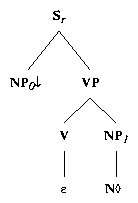
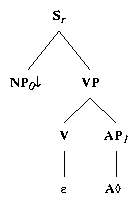
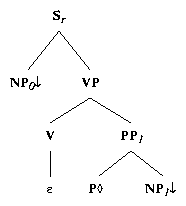
 |
 |
 |
||
| (a) | (b) | (c) |
The XTAG grammar provides a uniform analysis for the copula, raising verbs and small clauses by treating the maximal projections of lexical items that can be predicated as predicative clauses, rather than simply noun, adjective and prepositional phrases. The copula adjoins in for matrix clauses, as do the raising verbs. Certain other verbs (such as consider) can take the predicative clause as a complement, without the adjunction of the copula, to form the embedded small clause. The structure of a predicative clause, then, is roughly as seen in ((87))-((89)) for NP's, AP's and PP's. The XTAG trees corresponding to these structures9.3 are shown in Figures 9.1(a), 9.1(b), and 9.1(c), respectively.
The copula be and raising verbs all get the basic auxiliary tree as explained in the section on auxiliary verbs (section 21.1). Unlike the raising verbs, the copula also selects the inverted auxiliary tree set. Figure 9.2 shows the basic auxiliary tree anchored by the copula be. The <mode> feature is used to distinguish the predicative constructions so that only the copula and raising verbs adjoin onto the predicative trees.
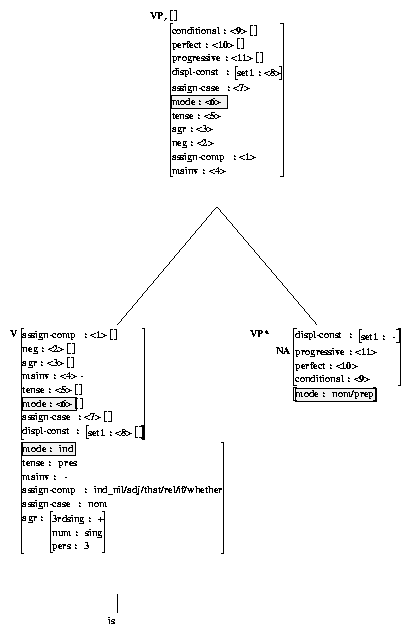 |
There are two possible values of <mode> that correspond to the predicative trees, nom and prep. They correspond to a modified version of the four-valued [N,V] feature described in section 9.2.3. The nom value corresponds to [N+], selecting the NP and AP predicative clauses. As mentioned earlier, they often pattern together with respect to constructions using predicative clauses. The remaining prepositional phrase predicative clauses, then, correspond to the prep mode. Figure 9.3 shows the predicative adjective tree from Figure 9.1(b) now anchored by upset and with the features visible. As mentioned, <mode>=nom on the VP node prevents auxiliaries other than the copula or raising verbs from adjoining into this tree. In addition, it prevents the predicative tree from occurring as a matrix clause. Since all matrix clauses in XTAG must be mode indicative (ind) or imperative (imp), a tree with <mode>=nom or <mode>=prep must have an auxiliary verb (the copula or a raising verb) adjoin in to make it <mode>=ind.
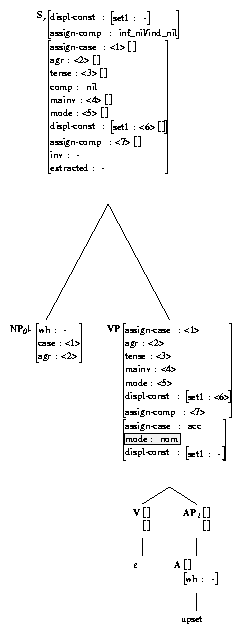 |
The distribution of small clauses as embedded complements to some verbs is also managed through the mode feature. Verbs such as consider and prefer select trees that take a sentential complement, and then restrict that complement to be <mode>=nom and/or <mode>=prep, depending on the lexical idiosyncrasies of that particular verb. Many verbs that don't take small clause complements do take sentential complements that are <mode>=ind, which includes small clauses with the copula already adjoined. Hence, as seen in sentence sets ((90))-((92)), consider takes only small clause complements, prefer takes both prep (but not nom) small clauses and indicative clauses, while feel takes only indicative clauses.
Figure 9.4 shows the tree anchored by consider that takes the predicative small clauses.
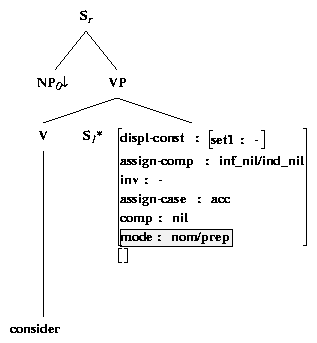 |
Raising verbs such as seems work essentially the same as the auxiliaries, in that they also select the basic auxiliary tree, as in Figure 9.2. The only difference is that the value of <mode> on the VP foot node might be different, depending on what types of complements the raising verb takes. Also, two of the raising verbs take an additional tree, Vpxvx, shown in Figure 9.5, which allows for an experiencer argument, as in John seems to me to be happy.
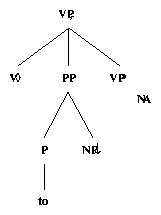 |
Raising adjectives, such as likely, take the tree shown in Figure 9.6. This tree combines aspects of the auxiliary tree Vvx and the adjectival predicative tree shown in Figure 9.1(b). As with Vvx, it adjoins in as a VP auxiliary tree. However, since it is anchored by an adjective, not a verb, it is similar to the adjectival predicative tree in that it has an at the V node, and a feature value of <mode>=nom which is passed up to the VP root indicates that it is an adjectival predication. This serves the same purpose as in the case of the tree in Figure 9.3, and forces another auxiliary verb, such as the copula, to adjoin in to make it <mode>=ind.
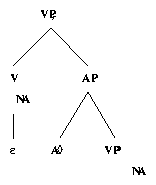 |